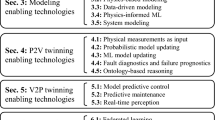Abstract
Concurrent Engineering (CE) is a popular method employed in product development. It treats the whole product design process by the consideration of product quality, cost, rate of progress, and demands of customers. The development of computer and network technologies provides a strong support to the realization of CE in practice. Aiming at the characteristics of CE and network collaborative design, this paper built network collaborative design system frame. Through the analysis of the network collaborative design modes based on CE, this paper provided a novel network collaborative design integration model. This model can integrate the product design information, design process, and knowledge. Intelligent collaboration was considered in the proposed model. The study showed that the proposed model considered main factors such as information, knowledge, and design process in collaborative design. It has potential application in CE fields.
Similar content being viewed by others
References
Caldwell, N. H. M., Clarkson, P. J., Rodgers, P. A. et al., 2000, “Web-Based Knowledge Management for Distributes Design,”IEEE Intelligent Systems and Their Applications, Vol. 15, No. 3, pp. 40–47.
Huang, G. Q., 1996, Design for X, Concurrent Engineering Imperative, Chapman & Hall, London.
Huang, G. Q., Lee, S. W. and Mak, K. L., 1999, “Web-Based Product and Process Data Modeling in Concurrent Design for X,”Robotics and Computer-Integrated Manufacturing, Vol. 15, No. 3, pp. 55–63.
Huang, H. Z., Bo, R. F. and Fan, X., 2005, “Concept Optimization for Mechanical Product Using Genetic Algorithm,”Journal of Mechanical Science and Technology, Vol. 19, No. 5, pp. 1072–1079.
Huang, H. Z., Zhou, F. and Zu, X., 2005, “Petri Nets Based Coordination Component for CSCW Environments,”Journal of Mechanical Science and Technology, Vol. 19, No. 5, pp. 1123–1130.
Maher, M. L. and Rutherford, J. H., 1997, “Model for synchronous collaborative design using CAD and database management,”Research in Engineering Design, Vol. 9, No. 2, pp. 85–98.
Nevins, J. L. and Whitney, D.E., 1991, Concurrent Engineering: Computer-Integrated Design and Manufacturing, McGraw-Hill Inc., New York, pp. 134–176.
Park, H. and Cutkosky, M. R., 1999, “Framework for Modeling Dependencies in Collaborative Engineering Processes,”Research in Engineering Design, Vol. 11, pp. 84–102.
Tian, L., 2002,Research on Theories and Support Technologies of Net-Based Collaborative Product Design, Tsing-hua University, Beijing.
Wang, B., 1998, Concurrent Design of Products, Manufacturing Process and Systems. Gorden and Breach Science Pub., Australia.
Author information
Authors and Affiliations
Corresponding author
Rights and permissions
About this article
Cite this article
Jiang, G., Huang, HZ., Fan, X. et al. Concurrent Engineering based collaborative design Under network environment. J Mech Sci Technol 20, 1534–1540 (2006). https://doi.org/10.1007/BF02916257
Received:
Revised:
Issue Date:
DOI: https://doi.org/10.1007/BF02916257




